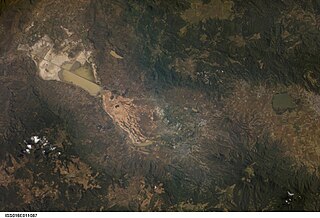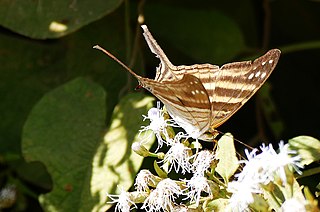
Ficus is a genus of about 850 species of woody trees, shrubs, vines, epiphytes and hemiepiphytes in the family Moraceae. Collectively known as fig trees or figs, they are native throughout the tropics with a few species extending into the semi-warm temperate zone. The common fig (F. carica) is a temperate species native to southwest Asia and the Mediterranean region, which has been widely cultivated from ancient times for its fruit, also referred to as figs. The fruit of most other species are also edible though they are usually of only local economic importance or eaten as bushfood. However, they are extremely important food resources for wildlife. Figs are also of considerable cultural importance throughout the tropics, both as objects of worship and for their many practical uses.

Ficus macrophylla, commonly known as the Moreton Bay fig or Australian banyan, is a large evergreen banyan tree of the Mulberry Family (Moraceae) native to eastern Australia, from the Wide Bay–Burnett region in the north to the Illawarra in New South Wales, as well as Lord Howe Island where the subspecies F. m. columnaris is a banyan form covering 2.5 acres or more of ground. Its common name is derived from Moreton Bay in Queensland, Australia. It is best known for its imposing buttress roots.

Ficus benjamina, commonly known as weeping fig, benjamin fig or ficus tree, and often sold in stores as just ficus, is a species of flowering plant in the family Moraceae, native to Asia and Australia. It is the official tree of Bangkok. The species is also naturalized in the West Indies and in the states of Florida and Arizona in the United States. Its small fruit are favored by some birds. Ficus tree has shown to have environmental benefits in urban areas like being a biomonitor. The plant also has allergens associated with it.

Ficus microcarpa, also known as Chinese banyan, Malayan banyan, Indian laurel, curtain fig, or gajumaru (ガジュマル), is a tree in the fig family Moraceae. It is native in a range from China through tropical Asia and the Caroline Islands to Australia. It is widely planted as a shade tree.

Ficus pumila, commonly known as the creeping fig or climbing fig, is a species of flowering plant in the mulberry family, native to East Asia and naturalized in parts of the southeastern and south-central United States. It is also found in cultivation as a houseplant. The Latin specific epithet pumila means "dwarf", and refers to the very small leaves of the plant.

Ficus aurea, commonly known as the Florida strangler fig, golden fig, or higuerón, is a tree in the family Moraceae that is native to the U.S. state of Florida, the northern and western Caribbean, southern Mexico and Central America south to Panama. The specific epithet aurea was applied by English botanist Thomas Nuttall who described the species in 1846.

The fig is the edible fruit of Ficus carica, a species of small shrub in the flowering plant family Moraceae, native to the Mediterranean region, together with western and southern Asia. It has been cultivated since ancient times and is now widely grown throughout the world. Ficus carica is the type species of the genus Ficus, containing over 800 tropical and subtropical plant species.

Marpesia is a butterfly genus in the family Nymphalidae. The species of this genus are found in the Neotropical and Nearctic realms.

Marpesia eleuchea, the Antillean daggerwing, is a species of butterfly of the family Nymphalidae. It is found in the West Indies. Occasional strays can be found in the Florida Keys.

Ficus septica, also known as the Hauili fig tree, is a species of shrub or tree in the family Moraceae found at low altitudes from north-eastern India to northern Australia (Queensland), and throughout Malesia. It lives on the edge of the vegetation, often in degraded environments. The seeds of this species are dispersed by numerous species, including fruit bats (Megachiroptera) when present.

Laguna de Sayula is a lake located in the southern area of Jalisco, about 60 km from Guadalajara. It is located in the municipalities of Sayula, Zacoalco de Torres, Amacueca, Teocuitatlán de Corona, Atoyac and Techaluta de Montenegro.

Marpesia furcula, the sunset daggerwing or glossy daggerwing, is a species of butterfly of the family Nymphalidae. It is found in Central and South America, from Nicaragua to Bolivia and Argentina. The habitat consists of evergreen rainforests at altitudes up to 1,400 meters.

Marpesia zerynthia, the waiter daggerwing, is a species of butterfly in the family Nymphalidae. Primarily found in Mesoamerica, it can also be observed in regions slightly north and south of this area.

Ficus auriculata is a type of fig tree, native to subtropical and tropical mainland Asia. It is noted for its big and round leaves and edible fruit.

Marpesia chiron, the many-banded daggerwing, is a species of daggerwings, map butterflies in the family Nymphalidae. It is found in Central America, North America, and South America.

Marpesia berania, the amber daggerwing, is a butterfly in the family Nymphalidae. The species was first described by William Chapman Hewitson in 1852. They are a brightly colored, Neotropical butterfly with a unique wing shape, found in Central and northern South America. The amber daggerwing exhibits several interesting characteristics varying from their unusual behavior to their physical traits that make them so distinct.

















